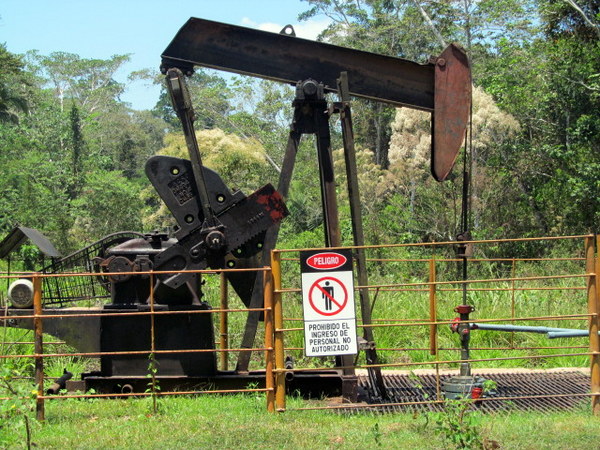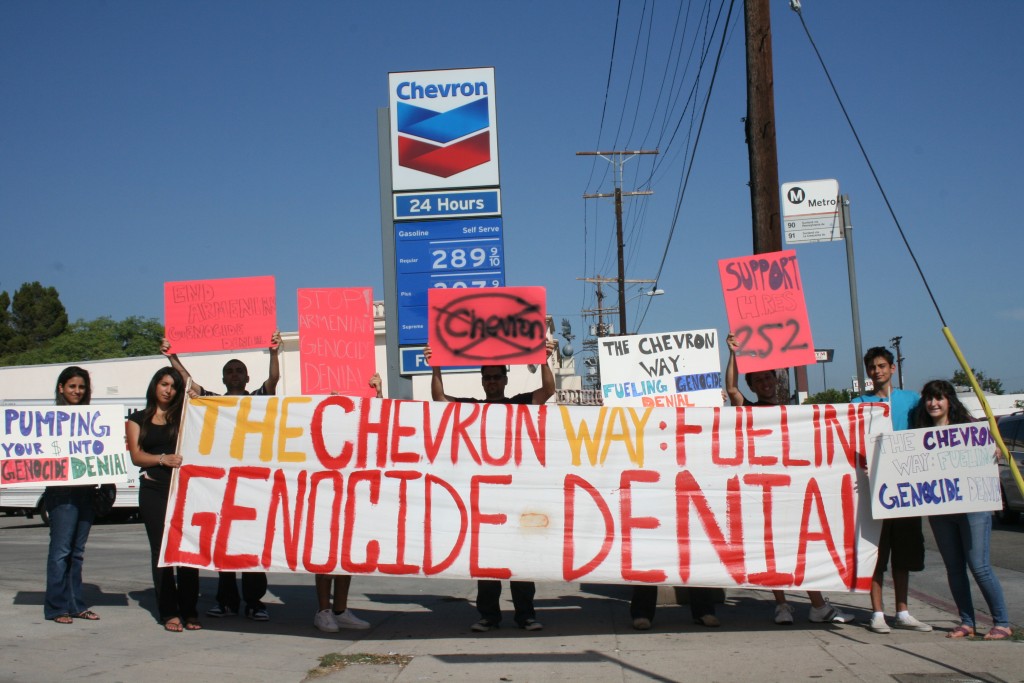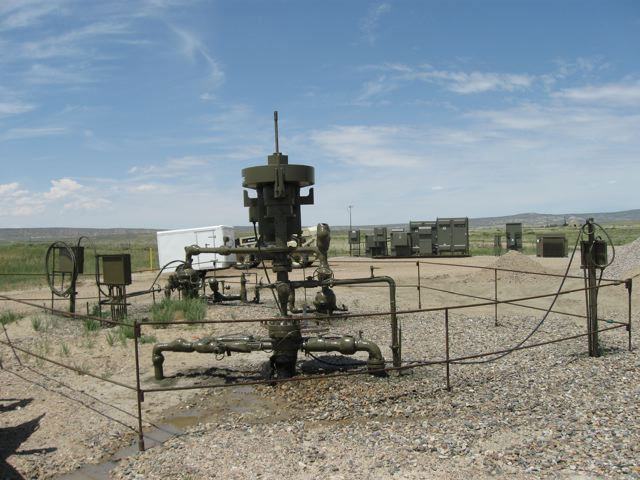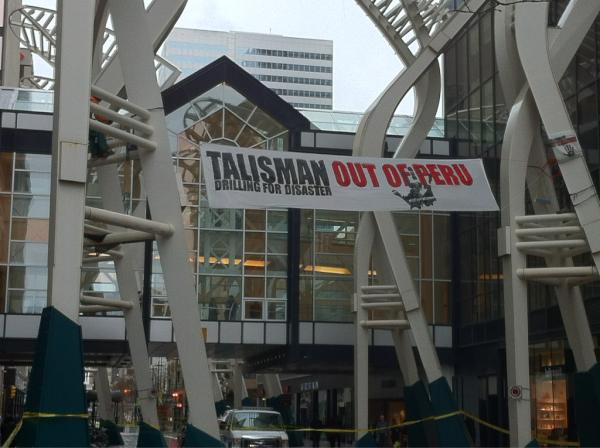
by Deep Green Resistance News Service | Oct 31, 2012 | Colonialism & Conquest, Indigenous Autonomy, Toxification
By Darrin Mortenson / Alianza Arkana
Even as indigenous people struggle to cope with current levels of contamination and illness caused by years of oil production in the Amazon, the governments of Peru and Ecuador are preparing to sell off even more Amazonian territory to the oil industry in coming months.
Starting in November, Peru’s state-run leasing agency Petroperu plans to start auctioning licenses to 36 new oil blocks for exploration, 19 of them in the northern region of Loreto. Just across the border, Ecuador is set to lease at least 13 blocks on or near waterways that eventually flow south into Peru and join the Amazon River.
Many of the blocks overlap or abut protected areas and indigenous territories and threaten the forests and rivers that indigenous people and other river people depend on for their lives.
Indigenous groups are rallying to stop their governments’ plans, and some talk of making a stand for a total moratorium on all exploration until both countries come up with a regional environmental plan.
“Oil production is an activity that definitely alters our territory, our environment, our health and our culture,” said Alfonso Lopez Tejada, leader of the federation of 57 indigenous Kukama communities along the Maranon river region in Peru, where three new lots overlap Kukama communities and threaten the famous Pacaya Samiria National Reserve.
“Again they impose these lots on us just as they did not consult us when they leased our territories before,” Lopez said.
In Ecuador, indigenous groups are planning demonstrations and marches to protest the new round of concessions begin on November 28.
“We are defending our land. We won’t allow oil activity,” said Franco Viteri, president of a Confederation of Indigenous Nationalities of the Ecuadorean Amazon (Confeniae), according to a recent article in the Wall Street Journal.
Ecuadorian indigenous leaders say they will make an appeal to the country’s Constitutional Court.
From Alianza Arkana
by Deep Green Resistance News Service | Oct 25, 2012 | Toxification
By Leo Hickman / The Guardian
Oil companies operating in the North Sea have been fined for oil spills on just seven occasions since 2000, even though 4,123 separate spills were recorded over the same period, the Department of Energy and Climate Change (Decc) has confirmed.
The disclosure came as Decc said on Thursday that the government had offered a “record-breaking” 167 new licences to oil and gas companies seeking to drill in the North Sea. A further 61 “blocks”, or licences, are under environmental assessment.
Total fines resulting from prosecutions between 2000 and 2011 came to just £74,000 and no single oil company had to pay more than £20,000.
Two companies received fines of £20,000: BP, for causing 28 tonnes of diesel to spill into the sea in 2002 from the Forties Alpha platform, and, a year later, Total E&P, for causing six tonnes of diesel to enter the sea during a transfer between fuel tanks on the Alwyn North platform.
Information about the fines was released by Decc after a freedom of information request and further inquiries by the Guardian.
The smallest fines over this period were those imposed on two companies, Venture North Sea Oil and Knutsen OAS Shipping, of £2,000 each, after 20 tonnes of crude oil was spilt during a tanker transfer on the Kittiwake platform.
In total, 1,226 tonnes of oil were spilt into the North Sea between 2000 and 2011, according to Decc’s archives. Decc said there is no “volume threshold” determining whether a company will be prosecuted over a spill at sea, although a spill of less than five tonnes is unlikely to go to court.
A tonne of crude oil is broadly equivalent to seven barrels, or, more precisely, 1,136 litres.
Decc said its inspectors, all of whom have enforcement powers, judge each case separately to assess the circumstances and the seriousness of the alleged offence.
Slightly different arrangements exist in Scotland from those in England, Wales and Northern Ireland, for pursuing a prosecution.
A Decc spokesman said: “The UK has one of the toughest and most successful oil and gas regimes in the world and we work closely with industry to ensure the highest standards of environmental protection are in place and enforced.
“There are a number of enforcement options available to Decc, with court action reserved for serious offences. On the rare occasions legal proceedings have been deemed necessary, it is for the court to decide the level of fines to hand down.”
Environmental campaigners said it was worrying that Decc viewed itself as operating the global gold standard of offshore regulation, especially as oil companies were now pressing for permission to drill in extreme and vulnerable environments such as the Arctic.
Vicky Wyatt, a Greenpeace campaigner, said: “Ministers and oil companies can spout all the carefully crafted quotes they like to tell us how safe drilling at sea is. But while they’re spouting these words, their rigs are all too often spouting oil into our oceans. The government should hit these companies who pollute the oceans in this way with meaningful fines.
“A few grand is not even a slap on the wrist for companies who pocket millions of pounds every hour.
“It’s both staggering and wrong that some of these companies are now also drilling in the fragile and pristine Arctic, where a similar oil leak would be catastrophic.”
Read more from The Guardian: http://www.guardian.co.uk/environment/2012/oct/25/oil-companies-north-sea-spills

by Deep Green Resistance News Service | Oct 10, 2012 | Lobbying, Toxification
By Jeff Gray / The Globe and Mail
Chevron Corp. has lost a bid to have the U.S. Supreme Court consider its call for a worldwide ban on attempts to collect on a controversial $19-billion (U.S.) environmental judgment levelled against the company in Ecuador.
The decision comes with lawyers in Canada poised to battle in a Toronto courtroom next month over an attempt by the Ecuadorean plaintiffs to seize Chevron’s considerable Canadian assets to cover at least part of the massive judgment – a judgment the oil giant dismisses as fraudulent.
In the latest twist in a tangled legal saga, Chevron was trying to revive a preliminary injunction issued last year by a federal judge in New York. That injunction was later overturned on appeal. It purported to block the plaintiffs and their lawyers from trying to enforce the 2011 Ecuadorean court ruling not just in the U.S., but anywhere outside of Ecuador.
The U.S. Supreme Court refused on Tuesday to hear the case. It issued no reasons, as is customary, leaving the appeal court decision that quashed the injunction in place.
The news comes as lawyers for the plaintiffs – a group of villagers in the Amazon rainforest – have stepped up their campaign to force the oil company to pay for environmental damage from oil pollution in the Lago Agrio area of Ecudaor.
Chevron, based in San Ramon, Calif., has said it has virtually no assets remaining in Ecuador, and the plaintiffs have vowed to chase the company’s assets elsewhere. Their first stop, earlier this year, was Canada.
In May, they announced they had retained prominent Toronto lawyer Alan Lenczner, of Lenczner Slaght Royce Smith Griffin LLP, to try to have the judgment recognized by the Ontario Superior Court and force Chevron to fork over its Canadian assets, which include oil sands holdings. The plaintiffs have also filed a similar collection effort in Brazil.
In sprawling litigation in the United States, both sides have accused each of fraud and bribery in connection with the Ecuadorean ruling, allegations they both deny.
Chevron said Tuesday in an e-mailed statement that the company was disappointed with the decision but “will continue to defend against the plaintiffs’ lawyers’ attempts to enforce the fraudulent Ecuadorean judgment, and to further expose their misconduct in our pending [litigation] in New York and other proceedings.”
The plaintiffs’ say the ruling is the latest in a series of defeats for Chevron in U.S. courts.
“Chevron’s latest loss before the Supreme Court is an example of the company’s increasingly futile battle to avoid paying its legal obligations in Ecuador,” Aaron Marr Page, a lawyer for the Ecuadoreans, was quoted as saying in an e-mailed statement.
Read more from The Globe and Mail: http://www.theglobeandmail.com/report-on-business/industry-news/the-law-page/chevron-loses-bid-to-have-ecuador-case-heard-by-us-supreme-court/article4599707/

by Deep Green Resistance News Service | Sep 20, 2012 | Toxification
By Abrahm Lustgarten / ProPublica
On a cold, overcast afternoon in January 2003, two tanker trucks backed up to an injection well site in a pasture outside Rosharon, Texas. There, under a steel shed, they began to unload thousands of gallons of wastewater for burial deep beneath the earth.
The waste – the byproduct of oil and gas drilling – was described in regulatory documents as a benign mixture of salt and water. But as the liquid rushed from the trucks, it released a billowing vapor of far more volatile materials, including benzene and other flammable hydrocarbons.
The truck engines, left to idle by their drivers, sucked the fumes from the air, revving into a high-pitched whine. Before anyone could react, one of the trucks backfired, releasing a spark that ignited the invisible cloud.
Fifteen-foot-high flames enveloped the steel shed and tankers. Two workers died, and four were rushed to the hospital with burns over much of their bodies. A third worker died six weeks later.
What happened that day at Rosharon was the result of a significant breakdown in the nation’s efforts to regulate the handling of toxic waste, a ProPublica investigation shows.
The site at Rosharon is what is known as a “Class 2” well. Such wells are subject to looser rules and less scrutiny than others designed for hazardous materials. Had the chemicals the workers were disposing of that day come from a factory or a refinery, it would have been illegal to pour them into that well. But regulatory concessions won by the energy industry over the last three decades made it legal to dump similar substances into the Rosharon site – as long as they came from drilling.
Injection wells have proliferated over the last 60 years, in large part because they are the cheapest, most expedient way to manage hundreds of billions of gallons of industrial waste generated in the U.S. each year. Yet the dangers of injection are well known: In accidents dating back to the 1960s, toxic materials have bubbled up to the surface or escaped, contaminating aquifers that store supplies of drinking water.
There are now more than 150,000 Class 2 wells in 33 states, into which oil and gas drillers have injected at least 10 trillion gallons of fluid. The numbers have increased rapidly in recent years, driven by expanding use of hydraulic fracturing to reach previously inaccessible resources.
ProPublica analyzed records summarizing more than 220,000 well inspections conducted between late 2007 and late 2010, including more than 194,000 for Class 2 wells. We also reviewed federal audits of state oversight programs, interviewed dozens of experts and explored court documents, case files, and the evolution of underground disposal law over the past 30 years.
Our examination shows that, amid growing use of Class 2 wells, fundamental safeguards are sometimes being ignored or circumvented. State and federal regulators often do little to confirm what pollutants go into wells for drilling waste. They rely heavily on an honor system in which companies are supposed to report what they are pumping into the earth, whether their wells are structurally sound, and whether they have violated any rules.
More than 1,000 times in the three-year period examined, operators pumped waste into Class 2 wells at pressure levels they knew could fracture rock and lead to leaks. In at least 140 cases, companies injected waste illegally or without a permit.
In several instances, records show, operators did not meet requirements to identify old or abandoned wells near injection sites until waste flooded back up to the surface, or found ways to cheat on tests meant to make sure wells aren’t leaking.
“The program is basically a paper tiger,” said Mario Salazar, a former senior technical advisor to the Environmental Protection Agency who worked with its injection regulation program for 25 years. While wells that handle hazardous waste from other industries have been held to increasingly tough standards, Salazar said, Class 2 wells remain a gaping hole in the system. “There are not enough people to look at how these wells are drilled … to witness whether what they tell you they will do is in fact what they are doing.”
Thanks in part to legislative measures and rulemaking dating back to the late 1970s, material from oil and gas drilling is defined as nonhazardous, no matter what it contains. Oversight of Class 2 wells is often relegated to overstretched, understaffed state oil and gas agencies, which have to balance encouraging energy production with protecting the environment. In some areas, funding for enforcement has dropped even as drilling activity has surged, leading to more wells and more waste overseen by fewer inspectors.
“Class 2 wells constitute a serious problem,” said John Apps, a leading geoscientist and injection expert who works with the U.S. Department of Energy’s Lawrence Berkeley National Laboratory. “The risk to water? I think it’s high, partially because of the enormous number of these wells and the fact that they are not regulated with the same degree of conscientiousness.”
Read more from ProPublica: http://www.propublica.org/article/trillion-gallon-loophole-lax-rules-for-drillers-that-inject-pollutants

by Deep Green Resistance News Service | Sep 14, 2012 | Colonialism & Conquest, Indigenous Autonomy, Mining & Drilling
By Amazon Watch
Today Talisman Energy (TLM) announced its decision to cease oil exploration activities in the Peruvian Amazon and to exit the country upon completion of ongoing commercial transactions.
“We have fought long and hard against Talisman’s drilling in our territory because of the negative environmental and social impacts we have seen from oil drilling around the world,” said Peas Peas Ayui, President of the National Achuar Federation of Peru (FENAP). “Now that Talisman is leaving we can focus on achieving our own vision for development and leave a healthy territory for future generations.”
Talisman is the fifth oil company to withdraw from controversial Block 64, located in the heart of indigenous Achuar territory in a remote and bio diverse region of the Amazon rainforest. Talisman has been exploring in Peru since 2004 and has come under increased pressure by human rights groups and shareholders for operating without Achuar consent.
“Talisman has had to face up to what the Achuar told them when they first invested in Block 64: The company cannot drill without the consent of the Achuar people,” said Gregor MacLennan, Peru Program Coordinator at Amazon Watch. “Talisman’s exit sends a clear message to the oil industry: Trampling indigenous rights in the rush to exploit marginal oil reserves in the Amazon rainforest is not an option.”
Despite Talisman’s claim of attaining local support from communities and signing good neighbor agreements with 66 communities downriver from their operations, the company never had the consent of the majority of communities living within Block 64. Talisman first invested in Peru one year after leaving Sudan and became sole operator in 2007, shortly after John Manzoni’s appointment as CEO. Manzoni was replaced by ex-TransCanada CEO Hans Kvisle on Monday this week.
“We are the owners and the original people of this land,” said Peas Ayui. “No outside person or company may enter our territory by force, without consultation and without asking us. We have been fighting against oil development on our land for 17 years and we maintain the same vision to protect our territory and resources for future generations. Let this be a clear message to all oil, mining and logging companies: we will never offer up our natural wealth so that they can extract our resources and contaminate our land.”
Block 64 is just one of several new efforts to extract oil from the headwaters of the Amazon in Northern Peru and Southern Ecuador, among the most bio diverse places on earth. Anglo-French company Perenco was recently awarded a production license to operate in Block 67 in Peru despite a legal case against them for drilling in isolated peoples’ territory. ConocoPhilliips has faced mass protests in Iquitos, Peru over plans to drill wells in a protected area in the Nanay river basin east of Block 64. In Ecuador, the government plans to auction new oil blocks on the Peruvian border despite strong indigenous opposition. The Kichwa community of Sarayaku recently won a case in the Inter-American Court of Human Rights against the Ecuadorian government for signing an oil contract without their consent or consultation.
From Amazon Watch: http://amazonwatch.org/news/2012/0913-talisman-energy-withdraws-from-peruvian-amazon




